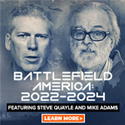
Junk food, cereal and snacks increasingly marketed to children through "pester power"
Monday, June 26, 2006 by: Dani Veracity
Tags: manipulative advertising, consumerism, parental responsiblility
- Newly released JFK files reveal Pentagon's role in creating Lyme disease and covid in the same lab
- Oncologist warns of ‘terrifyingly aggressive’ cancers in children, linked to immune suppression from COVID vaccines
- Trump administration CUTS FUNDING to Gavi, the Vaccine Alliance - a major blow to the Bill Gates-backed entity
- NIH study, buried for decades, reveals that Flu Shots INCREASE elderly deaths, not prevent them
- Health Ranger Report: Ashton Forbes discusses TELEPORTATION ORBS and their role in MH370 disappearance
- Musk targets “strangely wealthy” lawmakers in DOGE probe, names Pelosi, McConnell, Schumer
- COVID-19 scandal linked to CANCER SURGE: Billionaire researcher sounds alarm
- Millionaire fitness coach charged in Tesla vandalism incident as anti-Musk attacks escalate
- “Ethically sourced” human “bodyoids” could usher in a new era of medical exploitation, raising disturbing ethical questions
- EPA banned chemical linked to cancer, Parkinson's and fatal heart defects in babies - now industry is lobbying to get it reinstated
- Woman contracts WORLD'S DEADLIEST VIRUS after unknowingly being given the WRONG VACCINE
- DARPA: The shadowy innovator behind the world’s most advanced military technologies
- Ancient kitchen secrets REVEALED: How garlic, ginger and green onions fight cancer and heart disease
- Civil war is here – Multiple events, from conservatives being “swatted,” to attacks against Telsa owners, happening across America as Dem politicians are telling supporters to ‘fight in the streets”
- Tackling the rubber waste crisis: Groundbreaking study reveals eco-friendly method to recycle tires
- RFK Jr. is pushing Big Pharma ad ban - and corporate media is panicking
- Homesteading Boom: How families are escaping cities to grow their own food
- NYT admits U.S. ran Ukraine war operations-Russia's victory exposes obsolete NATO tactics, says Mike Adams
- Newly released JFK files reveal Pentagon's role in creating Lyme disease and covid in the same lab
- Analysis: The coming economic collapse, a mass uprising and Trump's three secret weapons to halt the growing revolt
- Trump's greatest betrayal so far: Accelerating Middle East wars, silencing dissent, and serving Zionist masters
- CDC finally halts $11 billion COVID funding scam as health officials admit the ‘pandemic’ was a fraud
- The hidden dangers in your kitchen: How cooking methods impact diabetes, cancer and aging
- Kiss Your Genetic Privacy Good-Bye! 23andMe Gets Green Light to Sell Your Intimate Genetic Details to Anyone They Want
- DEADLY DECEPTION: How COVID vaccines increased mortality rates and why authorities hid the truth
- Dr. Suzanne Humphries makes bombshell appearance on Joe Rogan podcast, exposing vaccine industry deception back to POLIOMYELITIS
- Trump nominates VACCINE ZEALOT Susan Monarez to lead the CDC, sidelining RFK Jr.'s reform efforts
- Here are TEN all-natural ways to protect your garden without using harmful chemicals
- Woman contracts WORLD'S DEADLIEST VIRUS after unknowingly being given the WRONG VACCINE
- Senate Democrats deny censorship industrial complex existed, defend government's role in silencing dissent
- Black cumin seed oil emerges as a powerful ally against breast cancer and chronic inflammation
- Sugar-free deception: Artificial sweeteners hijack hunger signals, fuel obesity epidemic, study warns
- “Independent” anti-Russia outlet MEDUZA faces COLLAPSE as US funding dries up
- The Health Ranger releases “Vaccine Zombie” song and music video, using AI-animated zombies for the music video
- Discovery of vast underground city beneath Giza pyramids challenges human history
- Key nodes of Federal Government censorship
- Newly released JFK files reveal Pentagon's role in creating Lyme disease and covid in the same lab
- California's social media censorship law struck down: A victory for free speech or a threat to online safety?
- EPA advisor admits the agency is funneling billions to climate groups ahead of Trump’s return to White House
- The Health Ranger releases “Vaccine Zombie” song and music video, using AI-animated zombies for the music video
- Dr. Mike Yeadon releases 15-minute testimony - WATCH - about genocidal intent of COVID “vaccines”
- Florida takes a stand: DeSantis proposes permanent ban on mRNA vaccine mandates
- “Why we influenced the 2020 elections”: Facebook files reveal the coordinated effort to bury the Hunter Biden laptop story
- Mike Adams releases country western hit single: Goin’ Back in Time is Comin’ Home
- The pandemic as a tool for INDOCTRINATION: Understanding “The Indoctrinated Brain” by Dr. Michael Nehls
- Unpacking the Lies That We’ve Been Fed – new song and music video released by Mike Adams, the Health Ranger
- Mike Adams releases music poetry sensation: A Child of God
- House Intelligence Committee calls for the ARREST and PROSECUTION of Dr. Anthony Fauci
- Rep. Nancy Mace introduces bill to ban biological males from female facilities on federal property
- Michigan sheriff announces criminal investigation into 2020 election crimes, Dominion Voting Systems
- Peter Rost exposes Big Pharma corruption in his book “The Whistleblower: Confessions of a Healthcare Hitman”
- Migrants are taking advantage of recent hurricanes to scam residents and loot their homes
- Sugarcane extract superior to cholesterol-lowering drugs?
- Survival 101: Effective EMF blocking techniques
- Red Cross issues warning to stop blood plasma donations from vaccinated people
- Scientists confirm: GENIUS brain function can be spontaneously unleashed in humans without any apparent cause
- EPA advisor admits the agency is funneling billions to climate groups ahead of Trump’s return to White House
- HYSSOP: What research reveals about the health benefits of this ancient holy herb
- Two containers with completed ballots fall out of truck in Florida
- Fully vaccinated about to see “tsunami” of illness and death, warns virologist
- Global leaders unite to clamp down on “misinformation” with UN-backed Cascais Declaration
- BREAKING: 2025 NDAA authorizes mandatory military draft of WOMEN across America… as Pentagon pursues global NUCLEAR war with both Russia and China at the same time
- Michael Yon warns of a ZIONIST TAKEOVER in Trump’s second administration
- BOMBSHELL: DNA testing kits are a SCAM to develop ethnic-specific bioweapons
- Ozempic and Wegovy weight loss drugs are injectable LIZARD VENOM PEPTIDES that may unleash a devastating wave of organ failure… side effects align with symptoms of SNAKE BITES
- Israeli soldiers accused of even more torture and abuse in the West Bank
- These 13 countries just signed an agreement to engineer a global FAMINE by destroying food supply
- NASA admits that climate change occurs because of changes in Earth’s solar orbit, and NOT because of SUVs and fossil fuels
- RFK Jr. clears key hurdle: Sen. Susan Collins backs controversial HHS nominee, signaling a new era for health policy
- Sermon 30: How Jesus reveals Caesar’s FAKE CURRENCY and FALSE AUTHORITY
- Coriander seeds: Ancient medicine backed by modern science
- Arizona officials claim Maricopa County needs 10-13 days to tabulate results of the election
Though Kroc and Disney began marketing their products specifically to children during the 1960s, child-centered marketing really didn't take hold until nearly twenty years later. The boost in children's advertising during the 1980s is a perfect example of how cultural change leads to more cultural change. During that time, more and more children began growing up with no stay-at-home parent, due to an increasing number of single-parent and two-working-parent households. In his bestselling book "Fast Food Nation," Eric Schlosser explains this cultural change's link with increased child-focused marketing: "Many working parents, feeling guilty about spending less time with their kids, started spending more money on them." Consequently, companies began directing their advertising toward children because suddenly the children could ask their parents for a product with a better chance of actually getting it.
This parental guilt gives children buying power, as it operates on the message, "I buy you what you want because I love you." As misguided as this belief is, working parents often feel that their job schedules and household duties give them little alternative to showing their love through material goods – and in effect, giving children "pester power."
Pester power simply describes children's ability to ask -- or, actually, nag -- their parents for products with a good chance of having their wishes granted. Some children have more pester power than others, and pester power takes many different forms, but one thing is for sure: Children quickly learn the pestering methods that work most effectively for their particular parents and then use them to the best of their advantage.
In his book "Kids as Customers," James U. McNeal divides these pestering methods into seven categories:
- The demonstrative nag -- characterized by throwing temper tantrums, holding one's breath and crying in a public place, usually a store; high risk for the child because the demonstrative nag may backfire and result in punishment for embarrassing the parent instead.
- The forceful nag -- extremely pushy but not as overtly threatening as the threatening nag; may involve phrases like, "If you don't buy it for me, I'll go ask mom and she will."
- The persistent nag -- asking for the same item over and over with the hope that the parent will eventually break down and give in.
- The pleading nag -- distinguishable by words like "please" and repetitive whining of the parent's name, such as "mom, mom, mom."
- The pity nag -- links parent's refusal to buy a product with claims of becoming a social outcast at school or being miserable forever.
- The sugar-coated nag -- exchanges affection for purchase; characterized by phrases like, "You're the best dad in the whole wide world."
- The threatening nag -- children learn blackmail early; involves threats of running away, hating a parent forever, refusing to go to school ever again, etc.
Giving in to pester power is ultimately bad for both parents and children; there are ways around it
Pester power is unfortunately common in modern American society, and it has a number of negative consequences. First of all, it teaches children instant gratification, which encourages children to focus on immediate pleasure rather than long-term consequences.Desire for instant gratification can make a 10-year-old choose to watch television rather than doing homework, regardless of the negative consequences that going to school without his or her homework will bring. However, if this focus on instant gratification continues until adulthood, the now 20-year-old adult may decide to sleep late rather than going to work, choosing immediate gratification (extra sleep) over fear of long-term consequences (getting fired). This is why it's important to teach children the importance of thinking things through and taking long-term consequences into account, rather than living life according to whims.
Solution: Don't give in to pester power – first explain to your child why, in the long run, it is better if you do not buy the product for him or her.
Second, giving in to pester power allows children to make decisions about topics like food choices that they don't have the maturity to make. Kelly Brownell and Katherine Battle Horgen explain this in their book "Food Fight:"
"The commercial exploitation of children ... is particularly egregious. Recognizing that children are not fully mature with regard to making informed decisions, we control the promotion of alcohol, firearms, and tobacco. Yet we assume that young children can rationally decide about food choices that have important health consequences, and we expose them to intense marketing of products that are largely devoid of nutritional value but replete with calories."
Of course children want that trip to McDonald's, bowl of ice cream or candy bar; it tastes good. Children, especially very young children, are not aware of junk food's negative effects on the body. Have you ever heard a 4-year-old ask how many calories his or her Happy Meal has? Kids don't pay attention to fat, calories and cholesterol, and the only thing they care about regarding sugar is that it tastes good.
Solution: Teach your children basic nutrition using the Honest Food Guide.
Giving in to pester power teaches children materialism, and materialistic goods will never substitute for your love and attention.
- Solution: If you work 40 hours per week, Monday through Friday, then make time for your children on weekends.
- Solution: Allot a certain time slot each evening for family time, even if it's just 30 minutes.
- Solution: Buy your child "just because" items sometimes but not all the time. This will make the items seem more special and will also avoid materialism.
The experts speak on pester-driven buying power
The history of direct-to-child advertising
[T]wenty-five years ago, only a handful of American companies directed their marketing at children -- Disney, McDonald's, candy makers, toy makers, manufacturers of breakfast cereal. Today children are being targeted by phone companies, oil companies, and automobile companies, as well as clothing stores and restaurant chains. The explosion in children's advertising occurred during the 1980s. Many working parents, feeling guilty about spending less time with their kids, started spending more money on them.Fast Food Nation by Eric Schlosser, page 43
To the great pleasure of the defendants and their supporters, however, the judge found not libelous the leaflet's assertions that McDonald's is cruel to animals, exploits children in its advertising practices, and depresses wages in the British fast-food industry. He said, for example: "In my judgment McDonald's advertising and marketing makes considerable use of susceptible young children to bring in custom [business], both their own and that of their parents who must accompany them, by pestering their parents ... [T]his is an inevitable result of advertising at all to children who cannot buy for themselves. So be it."
Food Politics by Marion Nestle, page 162
In his book "Kids As Customers" (1992), McNeal provides marketers with a thorough analysis of "children's requesting styles and appeals." He classifies juvenile nagging tactics into seven major categories. A pleading nag is one accompanied by repetitions of words like "please" or "mom, mom, mom." A persistent nag involves constant requests for the coveted product and may include the phrase "I'm gonna ask just one more time." Forceful nags are extremely pushy and may include subtle threats, like "Well, then, I'll go and ask Dad." Demonstrative nags are the most high-risk, often characterized by full-blown tantrums in public places, breath-holding, tears, a refusal to leave the store. Sugar-coated nags promise affection in return for a purchase and may rely on seemingly heartfelt declarations like "You're the best dad in the world." Threatening nags are youthful forms of blackmail, vows of eternal hatred and of running away if something isn't bought. Pity nags claim the child will be heartbroken, teased, or socially stunted if the parent refuses to buy a certain item. "All of these appeals and styles may be used in combination," McNeal's research has discovered, "but kids tend to stick to one or two of each that prove most effective … for their own parents."
Fast Food Nation by Eric Schlosser, page 45
The commercial exploitation of children ... is particularly egregious. Recognizing that children are not fully mature with regard to making informed decisions, we control the promotion of alcohol, firearms, and tobacco. Yet we assume that young children can rationally decide about food choices that have important health consequences, and we expose them to intense marketing of products that are largely devoid of nutritional value but replete with calories.
Food Fight by Kelly Brownell and Katherine Battle Horgen, page 97
Manipulative advertising at FETCH.news
Get independent news alerts on natural cures, food lab tests, cannabis medicine, science, robotics, drones, privacy and more.
Take Action: Support Natural News by linking to this article from your website
Permalink to this article:
Embed article link: (copy HTML code below):
Reprinting this article:
Non-commercial use OK, cite NaturalNews.com with clickable link.
Follow Natural News on Facebook, Twitter, Google Plus, and Pinterest
Science News & Studies
Medicine News and Information
Food News & Studies
Health News & Studies
Herbs News & Information
Pollution News & Studies
Cancer News & Studies
Climate News & Studies
Survival News & Information
Gear News & Information
News covering technology, stocks, hackers, and more



"Big Tech and mainstream media are constantly trying to silence the independent voices that dare to bring you the truth about toxic food ingredients, dangerous medications and the failed, fraudulent science of the profit-driven medical establishment.
Email is one of the best ways to make sure you stay informed, without the censorship of the tech giants (Google, Apple, Facebook, Twitter, YouTube, etc.). Stay informed and you'll even likely learn information that may help save your own life."
–The Health Ranger, Mike Adams













































